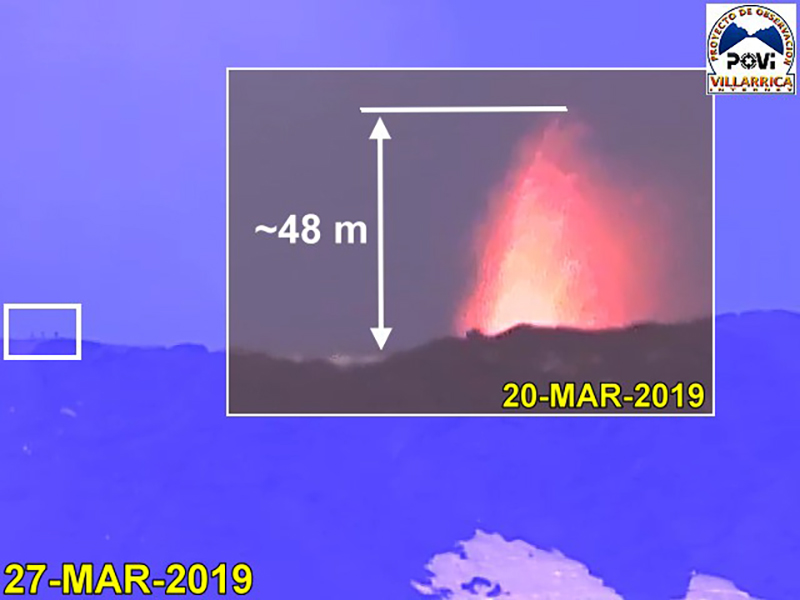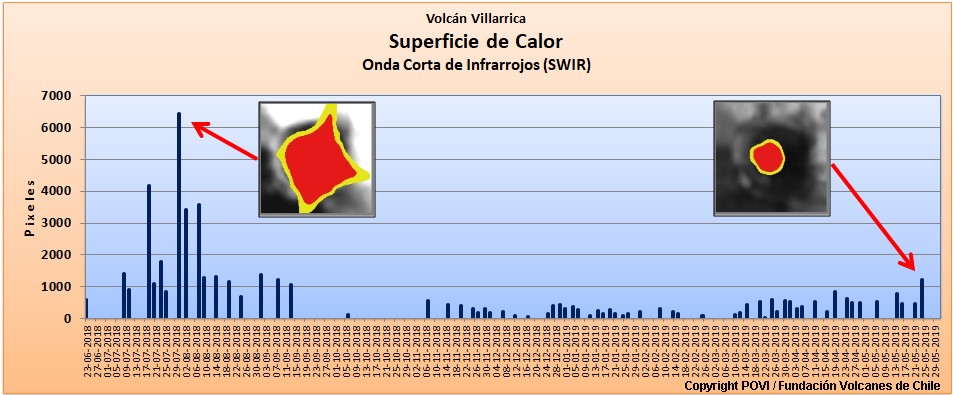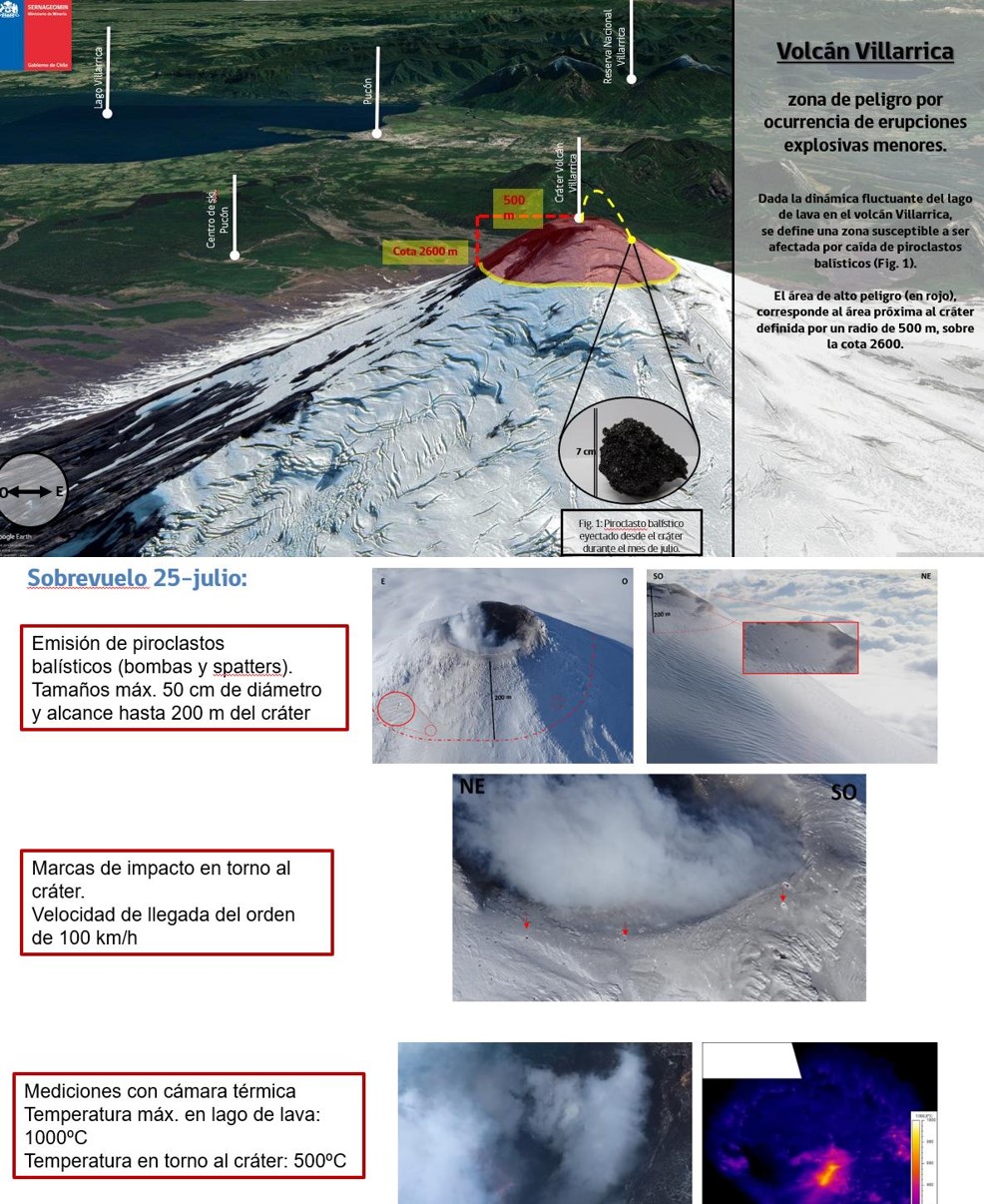Report on Villarrica (Chile) — September 2019
Bulletin of the Global Volcanism Network, vol. 44, no. 9 (September 2019)
Managing Editor: Edward Venzke.
Edited by Janine B. Krippner.
Villarrica (Chile) Strombolian activity continued during March-August 2019 with an increase in July
Please cite this report as:
Global Volcanism Program, 2019. Report on Villarrica (Chile) (Krippner, J.B., and Venzke, E., eds.). Bulletin of the Global Volcanism Network, 44:9. Smithsonian Institution. https://doi.org/10.5479/si.GVP.BGVN201909-357120
Villarrica
Chile
39.42°S, 71.93°W; summit elev. 2847 m
All times are local (unless otherwise noted)
Villarrica is a frequently active volcano in Chile with an active lava lake in the deep summit crater. It has been producing intermittent Strombolian activity since February 2015, soon after the latest reactivation of the lava lake; similar activity continued into 2019. This report summarizes activity during March-August 2019 and is based on reports from the Southern Andes Volcano Observatory (Observatorio Volcanológico de Los Andes del Sur, OVDAS), part of Chile's National Service of Geology and Mining (Servicio Nacional de Geología y Minería, SERNAGEOMIN), Projecto Observación Villarrica Internet (POVI), part of the Fundacion Volcanes de Chile research group, and satellite data.
OVDAS-SERNAGEOMIN reported that degassing continued through March with a plume reaching 150 m above the crater with visible incandescence through the nights. The lava lake activity continued to fluctuate and deformation was also recorded. POVI reported sporadic Strombolian activity throughout the month with incandescent ejecta reaching around 25 m above the crater on 17 and 24 March, and nearly 50 m above the crater on the 20th (figure 75).
There was a slight increase in Strombolian activity reported on 7-8 April, with incandescent ballistic ejecta reaching around 50 m above the crater (figure 76). Although seismicity was low during 14-15 April, Strombolian activity produced lava fountains up to 70 m above the crater over those two days (figure 77). Activity continued into May with approximately 12 Strombolian explosions recorded on the night of 5-6 May erupting incandescent ejecta up to 50 m above the crater rim. Another lava fountaining episode was observed reaching around 70 m above the crater on 14 May (figure 78). POVI also noted that while this was one of the largest events since 2015, no significant changes in activity had been observed over the last five months. Throughout May, OVDAS-SERNAGEOMIN reported that the gas plume height did not exceed 170 m above the crater and incandescence was sporadically observed when weather allowed. SWIR (short-wave infrared) thermal data showed an increase in energy towards the end of May (figure 79).
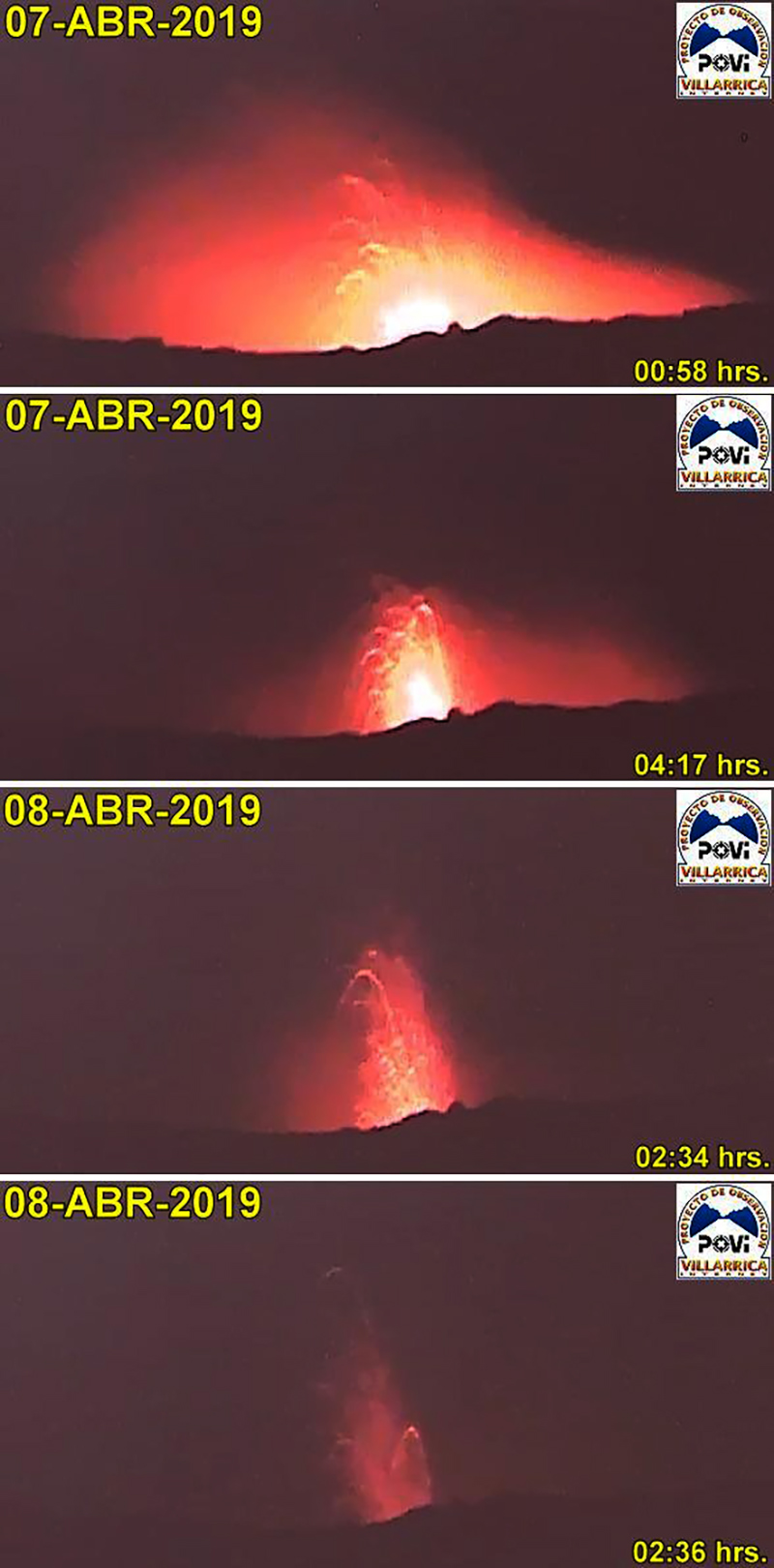 |
Figure 76. Strombolian activity at Villarrica on 7-8 April 2019 producing incandescent ballistic ejecta reaching around 50 m above the crater. Courtesy of POVI. |
 |
Figure 77. Images of Villarrica on 15 April show a lava fountain that reached about 70 m above the crater. Courtesy of POVI. |
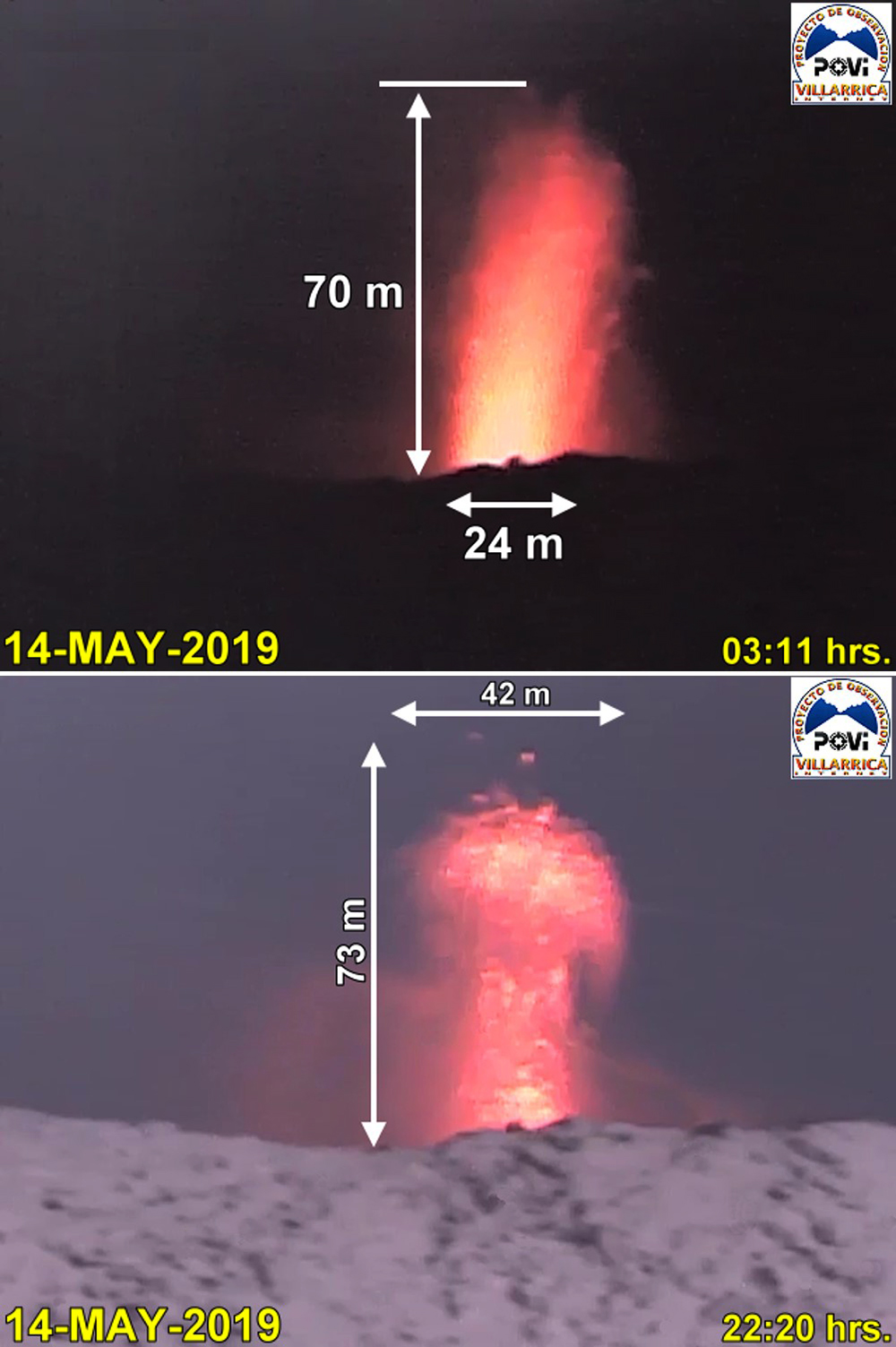 |
Figure 78. These images of Villarrica taken at 0311 and 2220 on 14 May 2019 show lava fountaining reaching 70-73 m above the crater. Courtesy of POVI. |
Ballistic ejecta were observed above the crater rim on 17 and 20 June 2019 (figure 80), and activity was heard on 20 and 21 June. Activity throughout the month remained similar to previous months, with a fluctuating lava lake and minor explosions. On 15 July a thermal camera imaged a ballistic bomb landing over 300 m from the crater and disintegrating upon impact. Incandescent material was sporadically observed on 16 July. Strombolian activity increased on 22 July with the highest intensity activity in four years continuing through the 25th (figure 81).
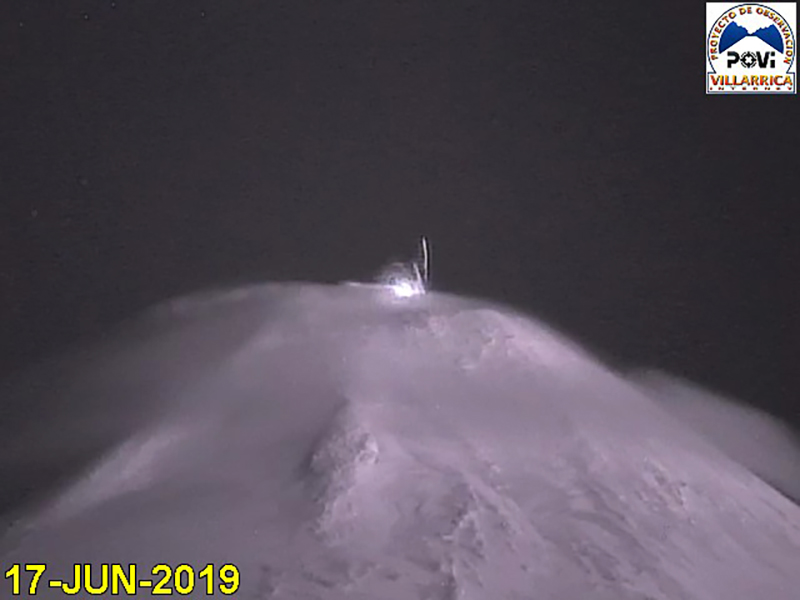 |
Figure 80. Ballistic ejecta is visible above the Villarrica crater in this infrared camera (IR940 nm) image taken on 17 June 2019. Courtesy of POVI. |
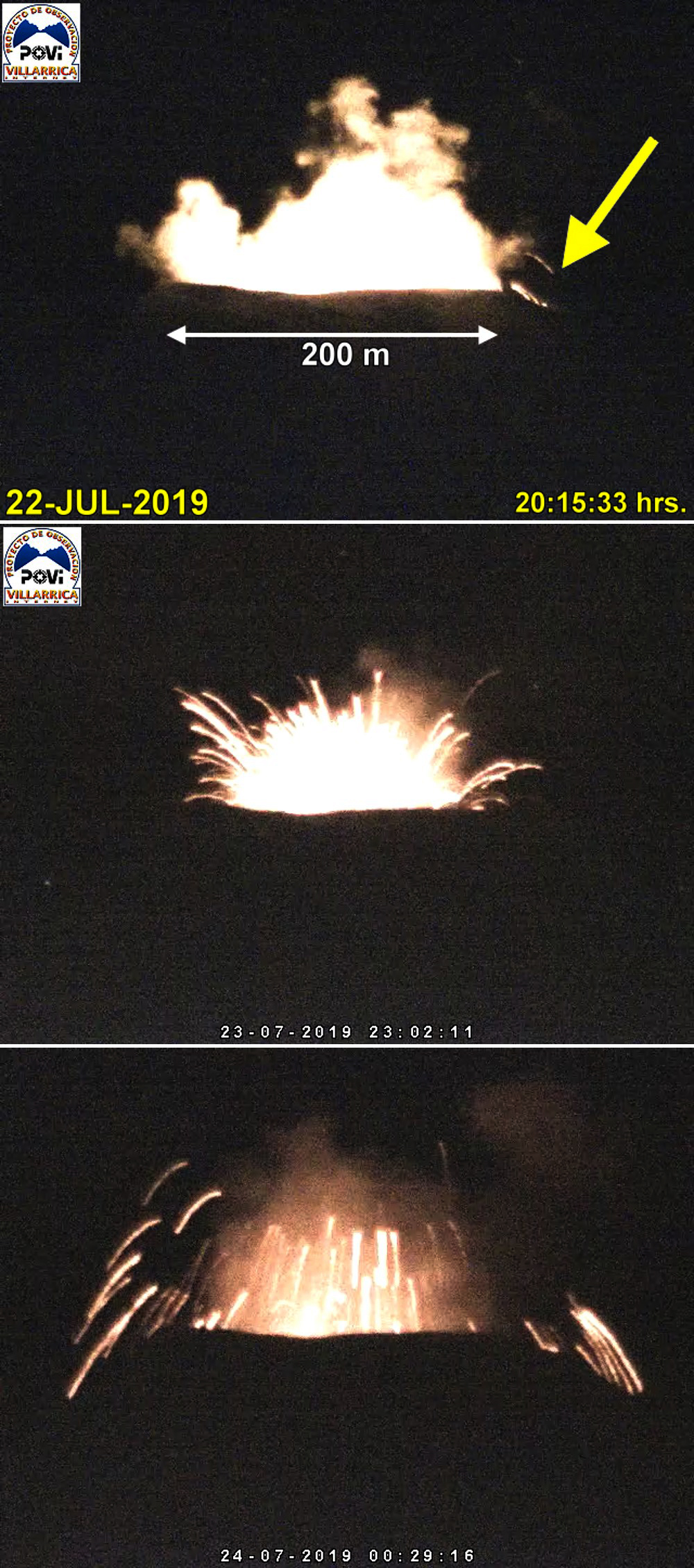 |
Figure 81. Strombolian activity at Villarrica on 22, 23, and 24 July with incandescent ballistic ejecta seen here above the summit crater. Courtesy of POVI. |
On 6 August the Alert Level was raised by SERNAGEOMIN from Green to Yellow (on a scale of Green, Yellow, Orange, and Red indicating the greatest level of activity) due to activity being above the usual background level, including ejecta confirmed out to 200 m from the crater with velocities on the order of 100 km/hour (figure 82). The temperature of the lava lake was measured at a maximum of 1,000°C on 25 July. POVI reported the collapse of a segment of the eastern crater rim, possibly due to snow weight, between 9 and 12 August. The MIROVA system showed an increase in thermal energy in August (figure 83) and there was one MODVOLC thermal alert on 24 July.
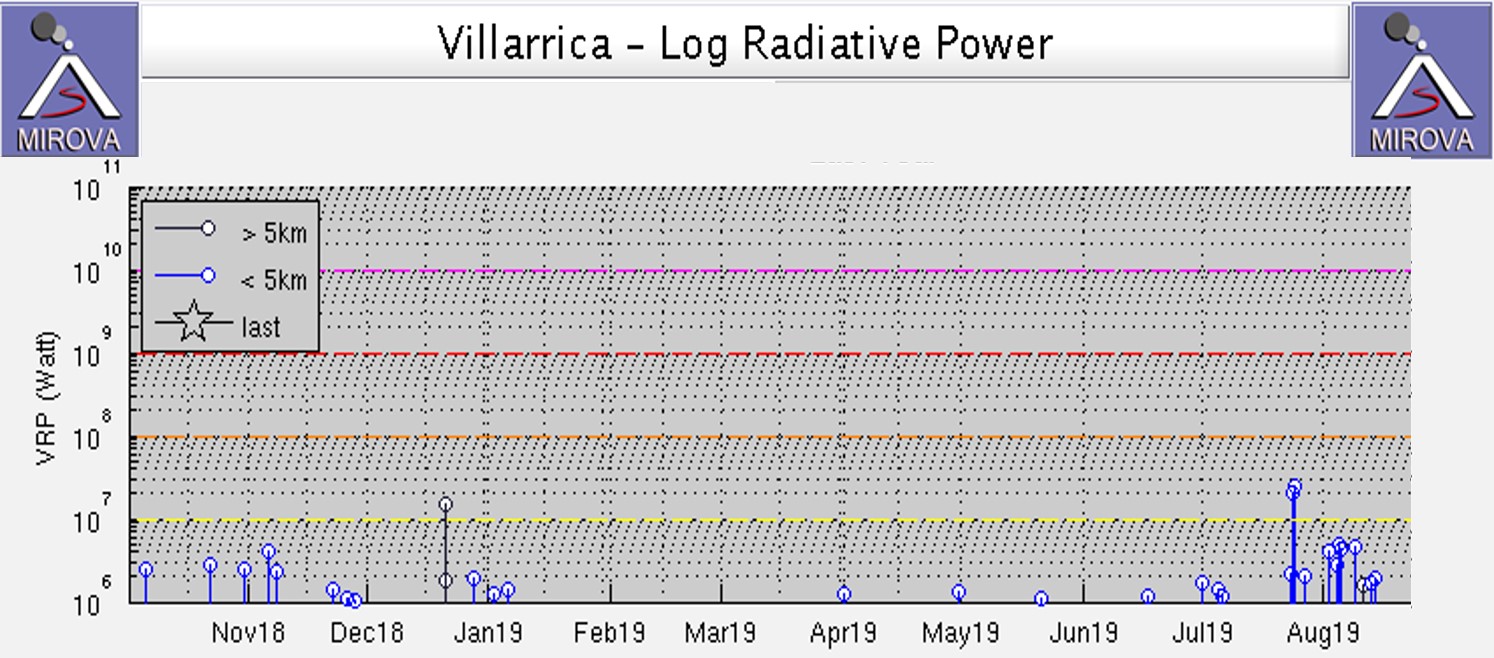 |
Figure 83. Thermal activity at Villarrica detected by the MIROVA system shows an increase in detected energy in August 2019. Courtesy of MIROVA. |
Geological Summary. The glacier-covered Villarrica stratovolcano, in the northern Lakes District of central Chile, is ~15 km south of the city of Pucon. A 2-km-wide caldera that formed about 3,500 years ago is located at the base of the presently active, dominantly basaltic to basaltic andesite cone at the NW margin of a 6-km-wide Pleistocene caldera. More than 30 scoria cones and fissure vents are present on the flanks. Plinian eruptions and pyroclastic flows that have extended up to 20 km from the volcano were produced during the Holocene. Lava flows up to 18 km long have issued from summit and flank vents. Eruptions documented since 1558 CE have consisted largely of mild-to-moderate explosive activity with occasional lava effusion. Glaciers cover 40 km2 of the volcano, and lahars have damaged towns on its flanks.
Information Contacts: Proyecto Observación Villarrica Internet (POVI) (URL: http://www.povi.cl/); Servicio Nacional de Geología y Minería (SERNAGEOMIN), Observatorio Volcanológico de Los Andes del Sur (OVDAS), Avda Sta María No. 0104, Santiago, Chile (URL: http://www.sernageomin.cl/); MIROVA (Middle InfraRed Observation of Volcanic Activity), a collaborative project between the Universities of Turin and Florence (Italy) supported by the Centre for Volcanic Risk of the Italian Civil Protection Department (URL: http://www.mirovaweb.it/); Hawai'i Institute of Geophysics and Planetology (HIGP) - MODVOLC Thermal Alerts System, School of Ocean and Earth Science and Technology (SOEST), Univ. of Hawai'i, 2525 Correa Road, Honolulu, HI 96822, USA (URL: http://modis.higp.hawaii.edu/).


